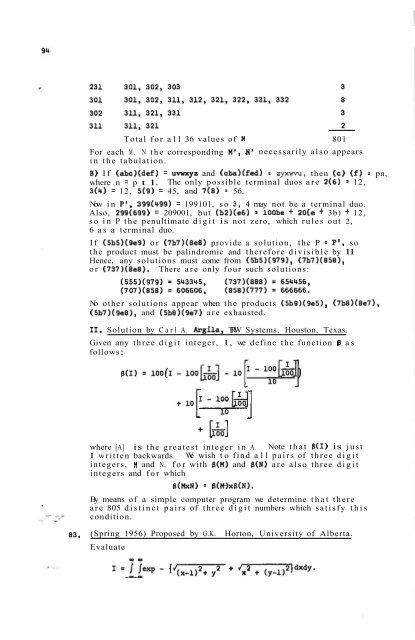Create successful ePaper yourself
Turn your PDF publications into a flip-book with our unique Google optimized e-Paper software.
Solution by <strong>Mu</strong>rray S. Klamkin, Ford Scientific Laboratory.It follows by symmetry thatTotal for all 36 values of M 801For each M, N the corresponding MI, N' necessarily also appearsin the tabulation.B) If (abc)(def) = uvwxyz and (cba)(fed) = zyxwvu, then (c) (f) = pn,where n = p t 1. The only possible terminal duos are 2(6) = 12,3(4) = 12, 5(9) = 45, and 7(8) = 56.<strong>No</strong>w in PI, 399(499) = 199101, so 3. 4 may not be a terminal duo.Also, 299(699) = 209001, but (b2)(e6) = lOObe + 20(e + 3b) + 12,so in P the penultimate digit is not zero, which rules out 2,6 as a terminal duo.If (5b5)(9e9) or (7b7)(8e8) provide a solution, the P = PI, sothe product must be palindromic and therefore divisible by 11Hence, any solutions must come from (5b5)(979), (7b7)(858),or (737)(8e8). There are only four such solutions:where c = fi.We first transform the rectangular coordinates (x,y) into ellipticcoordinates (E,n) (see Stratton, Electromagnetic Theory, McGraw-Hill, N.Y., 1941, pp. 52-54.)Herer tr1 2£EÑ 2c. n=- 1-22cand the region of integration is c > 1, -1 < n < 1.AlsoThus,2 EZ-,,~ 2 z 112dxdy = c { - a -1 dcdn.€2 1-nz<strong>No</strong> other solutions appear when the products (5b9)(9e5), (7b8)(8e7),(5b7)(9e8), and (5b8)(9e7) are exhausted.11. Solution by Carl A. Argila, TRW Systems, Houston, Texas.Given any three digit integer, I, we define the function B asfollows :Integrating with respect to n;<strong>No</strong>w let 6 = cosh0 giving-where [A] is the greatest integer in A. <strong>No</strong>te that B(1) is justI written backwards. We wish to find all pairs of three digitintegers, M and N, for with B(M) and B(N) are also three digitintegers and for whichB(HxN) = B(tt)xB(N).By means of a simple computer program we determine that thereare 805 distinct pairs of three digit numbers which satisfy thiscondition.83. (Spring 1956) Proposed by G.K. Horton, University of Alberta.EvaluateDifferentiating the known integralmKo(a) = f e-a cOshOdO (KO - modified Bessel function)0twice with respect to a, we obtain1K = ~ ( a )0a1 0Whence,m- -K (a) = f cosh20 e* c0sh8de.
















